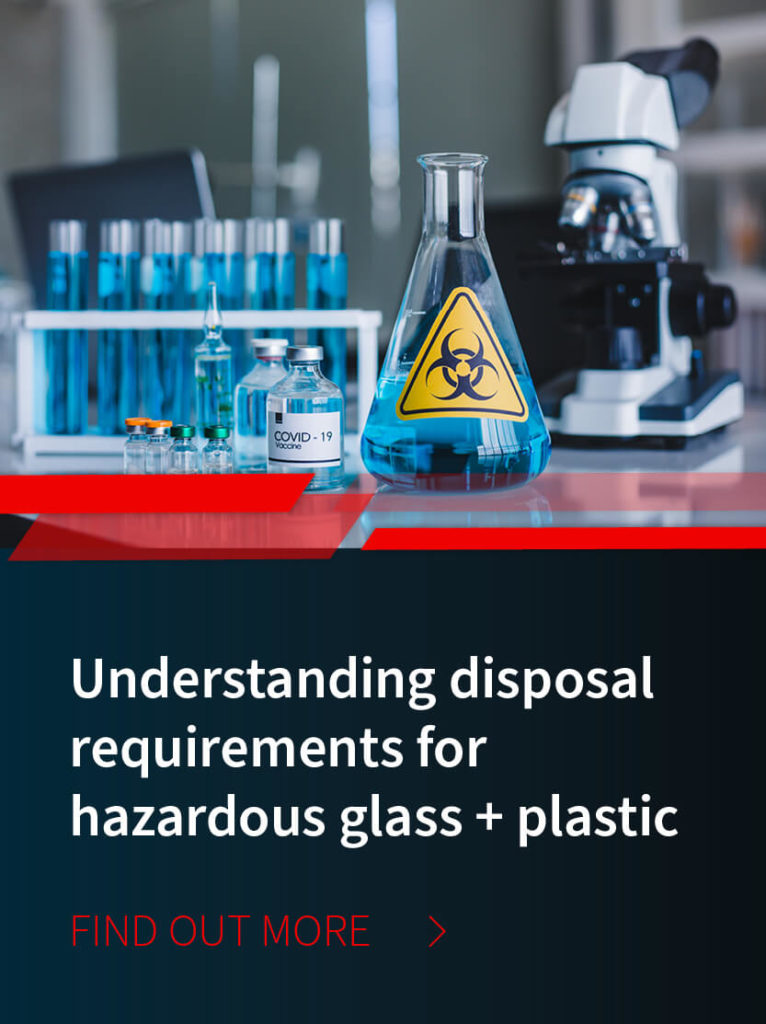
/ IN THIS BLOG
A vitally important and valuable document for any university is their hazardous waste disposal guidelines. Universities with lab rooms, research facilities, and medical training programs often utilizes a number of chemical agents. So too do the janitorial and/or maintenance department of any college or university.
Hazardous wastes in such scenarios might include but are not limited to unwanted or outdated chemicals, a spent chemical solution and other items that contain potentially hazardous materials such as electronics devices, fluorescent lamps, batteries, and so forth. Detailed information for academic labs in regard to such wastes are identified by the Environmental Protection Agency (EPA) guidelines found here.
As generators of hazardous waste, it’s critical for universities to have written, documented hazardous waste disposal guidelines for their employees. These help ensure safety regulations are known throughout the university campus and not just certain rooms or buildings on a campus. Every department that has anything to do with hazardous materials should know and understand these laws. If your university is without such guidelines or documents, create one. Now.
Turn to the EPA for guidelines regarding hazardous waste generators, management of laboratory hazardous wastes, and rules for academic labs to start. Then contact a hazardous waste management company such as MCF Environmental Services for guidance in developing such a document.
01 / Why Are Hazardous Waste Disposal Guidelines Important?
University hazardous waste disposal guidelines are critically important. Any person that has anything to do with hazardous waste (generating, identifying, storing, or transporting) should be familiar with this document and understand exactly what it says. Such a document details specific safety regulations as well as the university’s hazardous waste protocols that can be used across the campus in:
Laboratories (currently functioning or recently decommissioned)
Shops
Maintenance areas
Every hazardous waste generator – regardless of type of facility – is required to follow the federal regulations found in the Code of Federal Regulations Title 40, Part 262, subpart K. This section of the law refers to ‘Alternative Requirements for Hazardous Waste Determination and Accumulation of Unwanted Material for Laboratories Owned by Eligible Academic Entities’. However, it is highly recommended that all such entities also become familiar with the entirety of Part 262 as well.
Depending on what your university’s medical facilities produce, you might even have some hazardous medical waste on-site that the university’s hazardous waste disposal document specifically addresses. While it is common for large universities to have these documents in place due to greater resources and manpower to dedicate to creating these guidelines, smaller universities might not. Still, they are vitally important and the guidelines are applicable to all colleges and universities, including teaching hospitals associated with a university, a non-profit research institute, or collage.
In some cases, a hazardous waste disposal guide might be required in order to secure certain grants and confirm proper standard operating procedures. Smaller colleges and universities often need such funding. In cases of guidance, consider consulting with a reputable and experienced hazardous waste disposal company. A knowledgeable provider might help you put together an accurate and comprehensive guideline.
02 / What Hazardous Waste Disposal Guidelines Include
Guidelines in a hazardous waste disposal document often include basic sections in regard to purpose, scope, and definitions, to start. Regulatory authority for definitions belongs to the Resource Conservation and Recovery Act (RCRA) that mandates stipulations for identification, handling, labeling, storage, and disposal of hazardous waste.
The definition of RCRA hazardous waste is important. Everyone at the university must know what RCRA hazardous waste means and what categories of waste that includes. Identifying hazardous waste takes expertise and skill, but nobody should think it’s permissible to dump potentially hazardous material down the drain or throw it in the trash. Defining these terms within a document can provide everyone the base level of knowledge needed regarding RCRA law as well as the specifics of RCRA regulations.
Identification factors are determined by the characteristics of hazardous wastes and listed hazardous wastes, again defined by the RCRA here. The university hazardous waste disposal guide should also break down all the various types of hazardous waste. A characteristic hazardous waste chart is always helpful, including D-listed wastes with their accompanying D waste codes. (The RCRA 8—hazardous RCRA metals—falls under this umbrella.) The definitions and regulations of F-, K-, P-, and U-listed waste should also be included.
Proper hazardous waste storage protocols should also be defined in the document. Every university might have slightly different policies regarding hazardous waste storage, but these guidelines can also outline legal responsibilities in terms of what kind of containers to use, what materials not to store together, what hazardous waste labels to use, and how long you can have that waste on-site before shipment. Again, turn to Title 40 CFR parts 260 through 273 for more detailed information.
Safe practices for hazardous waste collection protocols should also be included, such as compatibility of chemical storage options or containers collected for disposal, container options, labeling guidelines, and limitations associated with certain types of hazardous waste.
Universal waste disposal protocols should also be included in the document. Universal waste is anything that is technically hazardous but appears in common items. Some examples include batteries, light bulbs, pesticides, anything with mercury, and so forth. Due to their ‘universal’ nature, municipal and commercial recycling programs for these items are relatively common. The university still needs to dispose of universal waste properly, but the protocols are less complicated than with other hazardous wastes.
03 / Why Universities Should use a Hazardous Waste Disposal Company
Federal and state regulations regarding university hazardous waste disposal processes can get complicated. It’s easy to get confused and even overwhelmed by all the detailed processes that must go into compliant guidelines. For this reason, working with an experienced and reputable hazardous waste management and disposal company is often the best (and most cost-effective) way to go. Such hazardous waste removal companies have hazardous waste disposal expertise to help create university hazardous waste disposal guidelines that improve overall safety and compliance of your university.
A full-service university waste management company can also help with the proper stages of disposal, from identification through to transport and treatment. For more information about safe and legal hazardous waste removal from your university and how such guidelines can help your university, reach out to a representative of MCF Environmental Services.
Robert Losurdo
President, COO








